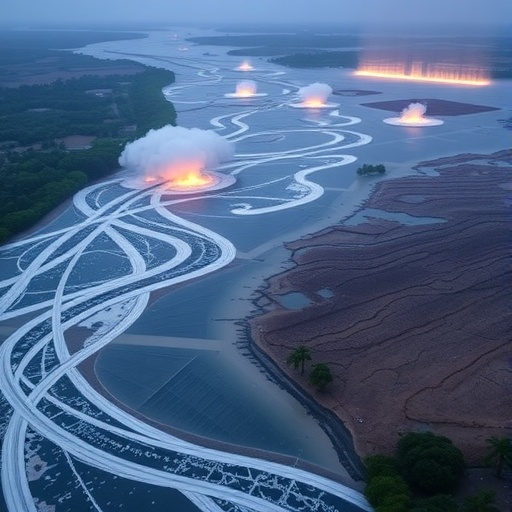A groundbreaking study from Pohang University of Science and Technology (POSTECH) has issued a stark warning about the future hydrological extremes facing Pakistan as a consequence of accelerating global warming. Led by Professor Jonghun Kam, this research employs an innovative artificial intelligence (AI) approach to overcome longstanding limitations of conventional climate modeling in complex mountainous regions, offering unprecedented insight into the periodicity and severity of extreme streamflow events threatening Pakistan’s vital river systems. The implications of these findings extend far beyond regional concerns, underscoring urgent global challenges in water resource management and climate adaptation.
Pakistan’s topography presents a unique and formidable challenge to climate scientists. The country’s major river basins, especially the Upper Indus Basin, traverse high-altitude, glacier-fed catchments interwoven with steep mountains and narrow valleys. Traditional climate models, developed primarily for broader, less complex terrain, frequently falter here. These models either underestimate the magnitude of hydrological extremes or overpredict precipitation, thereby generating uncertain forecasts. Such inaccuracies have made it difficult for policymakers and stakeholders to devise resilient strategies in an increasingly volatile climate context.
The team circumvented these challenges by integrating AI techniques that are capable of learning intricate patterns from observational data, enhancing the reliability of streamflow projections. By training AI models on historical river flow records and calibrating against actual observed data, they effectively reduced the biases inherent in traditional climate simulations. This methodological refinement enables the generation of more robust and granular forecasts, crucial for regions like the Upper Indus Basin where hydrological dynamics are heavily influenced by cryospheric processes and topographic complexity.
The study’s results are sobering. The AI-enhanced projections reveal a breathing pattern of extreme hydrological events: catastrophic floods and debilitating droughts that could arrive cyclically every 15 years in the upper reaches of the Indus River. Even more concerning, adjacent river systems are likely to endure these extremes at a higher frequency, approximately every 11 years. This pattern signals a new norm of hydrological uncertainty, with severe consequences for water security, agricultural productivity, and disaster preparedness in Pakistan’s densely populated and economically vulnerable zones.
The phenomenon of these recurring extremes is intimately tied to the rapid recession of glaciers throughout the Hindu Kush-Karakoram-Himalayan region. Global warming is accelerating glacial melt, which initially increases runoff and flood risks during warmer months, followed by protracted drought periods as glacial reserves diminish. The interplay between these phases creates a volatile oscillation of water availability, heightening the challenge of managing freshwater resources sustainably.
AI’s pivotal role in this study stems from its ability to bridge crucial data gaps that traditional hydrological models struggle with due to sparse observational networks and complex environmental interactions. Pakistan, classified among Global South countries, faces systemic constraints in climatic data collection infrastructure, making innovative modeling strategies even more indispensable. AI’s adaptability allows it to incorporate a diverse range of observational inputs, such as satellite data, ground stations, and historical records, thereby refining its predictive skill.
The implications for climate resilience policy are profound. Professor Kam emphasizes the need for adaptive water management frameworks that account for river-specific behaviors rather than blanket national strategies. Given the differential frequency and severity of streamflow extremes revealed by the AI projections, a one-size-fits-all approach would leave several basins unprepared for imminent challenges. Customized, basin-level plans that integrate AI-informed forecasts into infrastructure design, emergency response, and agricultural planning are essential to mitigate the looming crises.
Moreover, this research sets a precedent for deploying AI technologies in climate science globally, especially in regions characterized by complex geographies and limited resources. The collaboration between POSTECH and Sun Yat-sen University highlights the growing interdisciplinary and international efforts necessary to tackle climate vulnerability. Such partnerships enhance methodological innovations and knowledge transfer critical for building a worldwide climate resilience agenda.
This advancement also underscores the critical importance of enhancing observational data networks to feed increasingly sophisticated AI models. Investing in data acquisition technologies in vulnerable regions will significantly improve the granularity and accuracy of AI-based climate predictions. The synergy between improved data collection and AI-driven analysis offers a vital path forward in confronting abrupt climate shifts and their increasingly frequent manifestations.
While the study focuses on Pakistan, the methodology and findings bear relevance for many other mountainous regions around the world that experience similar glacial influences and topographical intricacies. Areas such as the Andes and the Alps may benefit from comparable AI-modeling strategies to assess streamflow extremes and develop region-specific adaptation protocols. The global nature of climate change demands that these technological advances be scaled and contextualized for diverse environments.
The findings arrive at a moment when climate-induced water crises are escalating worldwide. Extreme floods and droughts disrupt food systems, displace populations, and exacerbate geopolitical tensions. Pakistan, given its geopolitical position and demographic pressures, stands at a critical junction. Integrating AI-informed climate projections into national planning could enhance predictive disaster management and safeguard millions of lives and livelihoods.
In conclusion, this research by Professor Kam’s team marks a significant leap forward in hydrological forecasting under climate change stressors. By harnessing AI, the study not only improves predictive accuracy in a notoriously difficult setting but also provides actionable intelligence for policymakers. Its demonstration of periodic “super floods” and “extreme droughts” challenges existing paradigms and compels swift, adaptive responses both within Pakistan and in similarly at-risk regions worldwide.
Subject of Research: Hydrological extremes and streamflow projections in Pakistan’s Upper Indus Basin using AI-enhanced climate modeling.
Article Title: More record events in streamflow over Pakistan revealed by observation-constrained projections
News Publication Date: 25-Jul-2025
Web References: http://dx.doi.org/10.1088/1748-9326/adf130
References: Professor Jonghun Kam et al., Environmental Research Letters
Image Credits: POSTECH
Keywords: Applied sciences and engineering, Environmental sciences, Climatology, Environmental engineering, Abrupt climate change, Climate change adaptation, Climate change effects, Environmental issues, Greenhouse effect, Climate change, Earth sciences, Hydrogeology, Hydrological cycle, Fluid dynamics, Ice floes, Hydrology, Computer science, Artificial intelligence




